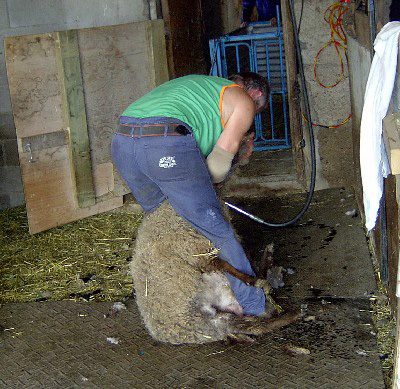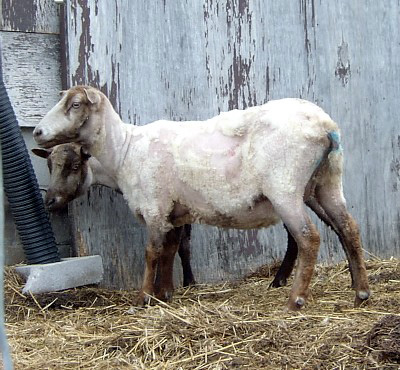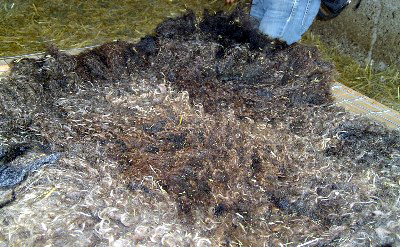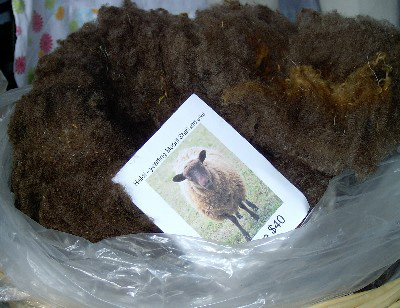|
I'm not a
new knitter, by any stretch of the
imagination, and I'm not uninformed
about fibers -- I know superwash merino
from hand-dyed cashmere. And I do
understand that wool comes from sheep
(and other assorted farm animals).
But it's amazing how much more there
is to it all.
  At
Toronto's Downtown Knit Collective
Spring Fling this year, I discovered
the Real Shetland line of wool products.
I fell in love straight away: they
offer a selection of yarns in two
weights -- a light worsted/DK, and
a fingering weight -- all in natural
sheep colors. Undyed, only lightly
processed, soft and really beautiful. At
Toronto's Downtown Knit Collective
Spring Fling this year, I discovered
the Real Shetland line of wool products.
I fell in love straight away: they
offer a selection of yarns in two
weights -- a light worsted/DK, and
a fingering weight -- all in natural
sheep colors. Undyed, only lightly
processed, soft and really beautiful.
For me, the most
remarkable thing was the colors --
not just creams and blacks, but warm
browns and soft greys and a delicious
shade of chocolate.
Real Shetland comes
from John and Lynn McKay's Woolly
Acres farm, north of Kingston,
in eastern Ontario. They raise two
flocks of sheep -- Dorpers for meat
and Shetlands for wool. This is their
very first year selling their wool
products. Their line includes products
from Michelle and Gil Minty's Hopeful
Shetlands farm in western Ontario.
  I
went out to Woolly Acres in May to attend their
Sheep Shearing Party. A local chapter of 4-H
had set up a barbeque, and were selling hot
dogs, cold drinks and home-made butter tarts
to raise funds for a trip to visit another farm
a few hours away. More than a hundred people
came by over the course of the morning -- to
watch the shearing, to visit the family, to
buy fleeces and wool, and just to be sociable. I
went out to Woolly Acres in May to attend their
Sheep Shearing Party. A local chapter of 4-H
had set up a barbeque, and were selling hot
dogs, cold drinks and home-made butter tarts
to raise funds for a trip to visit another farm
a few hours away. More than a hundred people
came by over the course of the morning -- to
watch the shearing, to visit the family, to
buy fleeces and wool, and just to be sociable.
When we arrived,
the sheep for shearing were lined
up in a pen in a barn, waiting. A
group of spinners were lined up in
the open area of the barn, waiting
perhaps a little less patiently.
It doesn't take
long to shear a sheep. Once secured
by the shearer, the sheep becomes
completely docile. From the lay perspective,
it's a big hairy lump submitting to
a rather extreme haircut.

  The
result of that haircut is magical,
though. The
result of that haircut is magical,
though.
The
poor sheep wanders off, looking rather
dazed and chilly.
The fleece itself
is laid out in a single piece.
The spinners fall
upon it, examining it closely. Lock
structure is important -- that is,
the shape and texture of the "curls".
Like a hairstylist, you want even
and well-defined curls.
  I
met Molly Wolf, editor of the KnitLit
series, as she was examining a fleece.
Spinners like Molly attend these events
with great pleasure. Absolutely, you
can buy roving at your local yarn
store, but the purest spinning experience
is to buy a whole fleece and take
it through the entire process yourself,
from washing to spinning to knitting
to wearing. I
met Molly Wolf, editor of the KnitLit
series, as she was examining a fleece.
Spinners like Molly attend these events
with great pleasure. Absolutely, you
can buy roving at your local yarn
store, but the purest spinning experience
is to buy a whole fleece and take
it through the entire process yourself,
from washing to spinning to knitting
to wearing.
Just to get to
a roving from a fleece requires a
multitude of steps, and as with any
group of experts gathered together,
tips were exchanged. ("In the washing
machine?" "Well, of course, on the
delicate cycle.") First step is to
pick off all the vegetable matter
-- that is, bits of grass and hay.
Next, the fleece much be carefully
washed. From there, the fleece is
carded -- that is, carefully brushed
to align and even out the fibers.
The carded fibers are then ready for
spinning.
Fleeces were available
for sale, each marked with key information
like the type, age and color of the
sheep -- and also its name. There
aren't many sheep producers in Ontario,
and those in the business do it for
love.
  Fleeces
not sold to spinners are sent off
to a depot to be processed into rovings
and yarns, which are sold under the
name Real Shetland. Fleeces
not sold to spinners are sent off
to a depot to be processed into rovings
and yarns, which are sold under the
name Real Shetland.
The farm also has
two llamas and an alpaca, as guard
animals. They live peaceably with
their flock, becoming aggressive and
territorial only when strange animals
stray too close. The llama and alpaca
fibers are sold, too, as fleeces and
in rovings, blended with Shetland.
Real Shetland products
were a revelation to me. Not only
are they beautiful, but they're an
absolute pleasure to work with. The
colors are rich and complex. They
have much more lanolin still intact
than the majority of commercially
produced yarns, which keeps the fibers
soft and moisturizes your hands as
you handle it. Even the scent is subtle
and somehow soothing.
As a knitter, it's
easy to forget about where fibers
come from. Even a dedicated spinner
may never work with anything other
than a bag of prepared roving from
her local yarn store.
Not everyone is
up to the challenge of preparing a
fleece. For the rest of us, Real Shetland
yarns and rovings are a tremendous
way to get closer to the source.
For more information
on the farm, and to buy wool products,
visit www.woollyacresfarm.com.

Denny's tips
for working with Shetland fleeces
Shetland fleeces
are small. Keep that in mind when
picking a project. Their modest size
makes them a terrific place to start
if you want to tackle the full DIY
fleece prep experience.
In Denny's words:
"Better to deal with just a few
pounds of farm smell, than... oh,
let's say 10 POUNDS OF FARM STINK.
Don't ask me how I know; I live in
denial."
Some Shetlands
sport a double coat -- that is, there
are long hairy bits as well as shorter
downy bits. This can be handled one
of two ways. You can comb out the
fiber on wool combs. Slowly. Carefully.
Or just send the thing off to a wool
mill and get them to deal with the
hairy bits. (This is what the farmers
do.) After all, you only want to work
with the nice soft downy bits. Of
course, if you aren't bothered with
the hairy bits, leave them in. It
will make for a rougher yarn, but
really terrific felt.
Much like Denny
herself, Shetland fleeces may be small,
but that doesn't mean they're easy.
|

